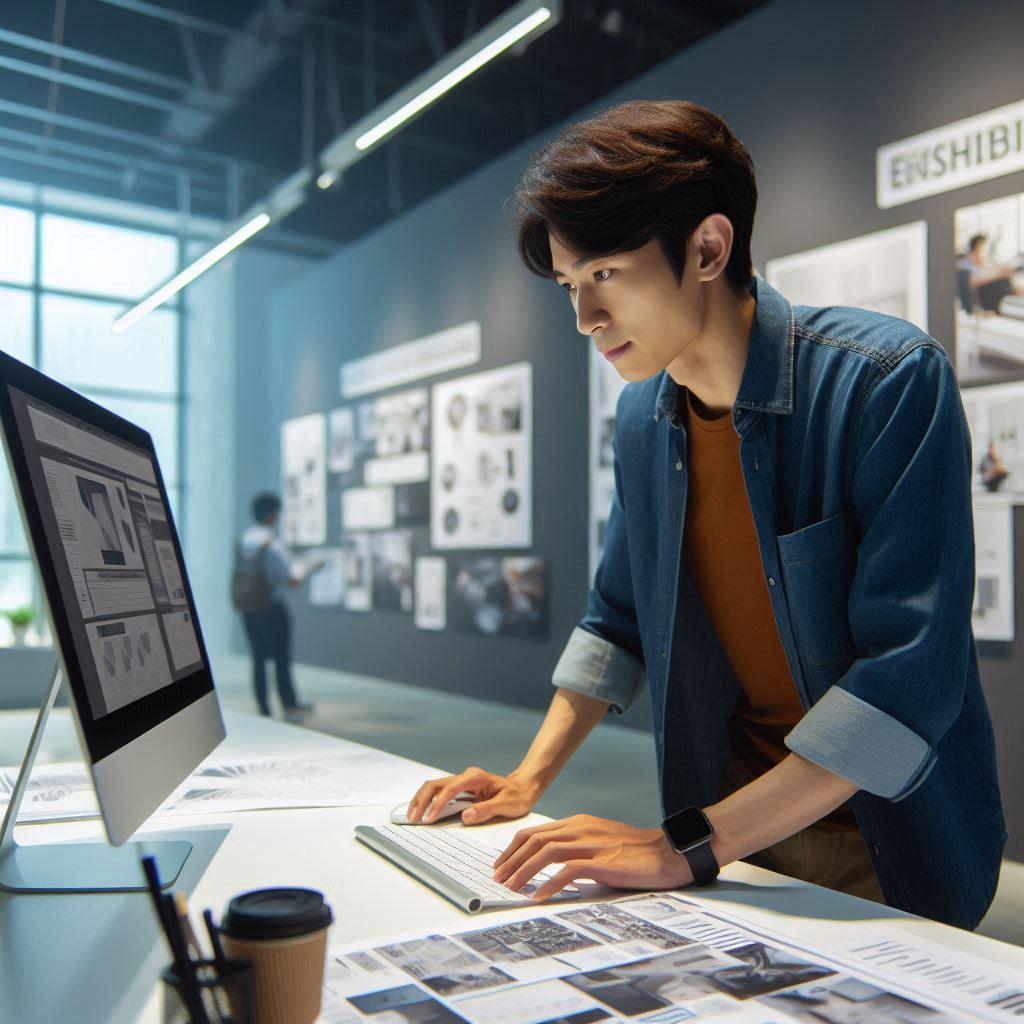Introduction
Exhibition design is the art and science of creating engaging environments that effectively showcase products, services, or ideas.
It involves a multifaceted approach, integrating elements of architecture, graphic design, and spatial planning.
Designers focus on crafting immersive experiences that resonate with audiences, using various tools and techniques to enhance visual storytelling.
Whether it‘s a trade show booth, a museum installation, or a corporate event, exhibition design aims to capture attention and facilitate meaningful interactions.
The importance of exhibition design spans multiple industries, making it a vital component of effective communication and marketing strategies.
In the marketing realm, well-designed exhibitions attract potential clients and serve as powerful platforms for brand storytelling.
They not only highlight a company’s offerings but also create an emotional connection with visitors.
Thoughtful design can elevate a brand’s presence, making it memorable and impactful in a crowded marketplace.
In the educational sector, museums and galleries rely on skilled exhibition design to enhance learning experiences.
Engaging layouts and interactive elements encourage visitors to explore and absorb information more deeply.
Effective design transforms static displays into dynamic learning environments that foster curiosity and engagement.
This approach is particularly valuable in inspiring young minds and sparking interest in various subjects.
Creativity in Exhibition Design
Ability to Think Outside the Box
Creativity stands as a cornerstone in exhibition design.
Designers must think outside the box to create compelling experiences.
Unique and visually appealing displays draw visitors in and leave lasting impressions.
Imagination fuels the design process, making it essential for every exhibition designer.
Exhibition designers often face the challenge of standing out.
They need to envision spaces that captivate audiences and convey messages effectively.
By thinking creatively, they can transform ordinary concepts into extraordinary displays.
Designers should focus on originality to differentiate their exhibitions from competitors.
Designing Unique and Visually Appealing Displays
Designing unique and visually appealing displays is crucial in capturing attention.
Color, shape, and texture play significant roles in this process.
Using vibrant colors can evoke emotions and attract attention.
Unique shapes can lead visitors through the space and highlight key areas.
Texture adds depth and interest, enhancing the sensory experience of the display.
Storytelling is another critical aspect of designing engaging displays.
Designers should weave narratives into their exhibitions to connect with visitors.
A well-told story can transform a simple exhibition into an immersive journey.
This approach encourages visitors to connect with the content emotionally.
Incorporating Creative Elements to Attract and Engage Visitors
Incorporating creative elements enhances the overall visitor experience.
This can include interactive installations, multimedia presentations, or striking visuals.
These elements help to engage visitors and make the exhibition memorable.
When designers embrace innovation, they can create environments that resonate with attendees.
Inspiration can come from various sources, including art, architecture, and nature.
Designers should seek out diverse influences to enrich their work.
Collaborating with artists or other creative professionals can spark new ideas.
This collaboration often leads to innovative solutions and fresh perspectives.
Experimentation is vital in the creative process.
Designers should feel free to try new techniques and materials.
Testing different concepts allows them to discover what resonates with their audience.
Failing is often a part of this journey; it leads to growth and refinement.
Feedback plays an essential role in refining creative ideas.
Seeking input from peers or mentors can provide valuable insights.
Constructive criticism helps designers identify areas for improvement.
This process strengthens the final product and enhances the visitor experience.
Creativity is vital for success in exhibition design.
The ability to think outside the box allows designers to create unique displays.
Incorporating creative elements not only attracts visitors but also engages them.
Embracing innovation and storytelling transforms exhibitions into unforgettable experiences.
Aspiring exhibition designers should nurture their creativity to thrive in this dynamic field.
Read: Freelance Character Design: How to Get Started
Attention to Detail in Exhibition Design
Precision in Layout and Placement of Exhibits
Attention to detail is crucial in exhibition design.
Precision in layout and placement of exhibits can make or break an experience.
A well-planned layout guides visitors seamlessly through the space.
It allows for effective storytelling and enhances overall engagement.
Designers must carefully consider how each element interacts within the environment.
Each exhibit should be positioned to maximize visibility and impact.
Designers should assess sightlines and accessibility to ensure optimal viewing.
Strategic placement can highlight key messages and draw attention to essential features.
Attention to these details ensures that visitors absorb the content effectively.
Ensuring All Elements Are Cohesive and Well-Integrated
Cohesion is another critical aspect of attention to detail.
Ensuring all elements are cohesive and well-integrated creates a harmonious environment.
Designers should maintain a consistent theme and style throughout the exhibition.
This includes color palettes, typography, and materials used in displays.
When elements are aligned, the exhibition communicates a clear message.
A cohesive design helps reinforce the overall narrative and intent.
It fosters an immersive experience where visitors can easily navigate and engage.
Attention to detail in this area strengthens the exhibition‘s impact.
Checking for Any Inconsistencies or Errors in Design
Checking for inconsistencies or errors in design is vital to maintain professionalism.
Designers should conduct thorough reviews of their work before implementation.
This includes scrutinizing signage, graphics, and interactive elements.
Ensuring accuracy and clarity minimizes confusion for visitors.
Errors can detract from the exhibition’s credibility and overall effectiveness.
A simple typo or misplaced element can lead to misinterpretation.
Designers must strive for precision to uphold the integrity of their message.
Regular checks and feedback can help identify and rectify issues early.
Collaboration with team members can enhance attention to detail.
Fresh eyes often spot inconsistencies that may go unnoticed.
Engaging in open communication fosters a culture of quality and excellence.
Team reviews encourage a collective responsibility for the exhibition‘s success.
Attention to detail is essential in exhibition design.
Precision in layout and placement enhances visitor engagement.
Ensuring cohesion across elements creates a unified experience.
Regular checks for inconsistencies maintain the exhibition‘s credibility.
Aspiring exhibition designers should cultivate a meticulous approach to thrive in this competitive field.
Read: Career Paths: Becoming a Professional Character Designer
Technical Skills in Exhibition Design
Proficiency in Design Software
Technical skills are fundamental for success in exhibition design.
Proficiency in design software, such as Adobe Creative Suite, is essential.
Designers use tools like Photoshop, Illustrator, and InDesign to create visually appealing layouts.
Mastery of these programs allows designers to bring their ideas to life effectively.
These software applications enable designers to manipulate images and create graphics.
With strong design skills, they can develop engaging presentations and marketing materials.
Proficiency in these tools helps streamline the design process and enhances overall productivity.
Knowledge of Lighting and Audiovisual Equipment
Knowledge of lighting and audiovisual equipment is another critical technical skill.
Effective lighting can dramatically influence the atmosphere of an exhibition.
Designers should understand how different lighting techniques affect visibility and mood.
This knowledge helps create immersive environments that captivate visitors.
Additionally, audiovisual elements enhance the experience by providing dynamic content.
Designers must be familiar with integrating sound, video, and interactive technologies.
Understanding how to use these tools ensures a seamless visitor experience.
A well-executed audiovisual presentation can leave a lasting impression.
Understanding of Materials and Construction Techniques
Understanding materials and construction techniques is vital for practical exhibition design.
Designers should be aware of the properties of various materials, such as wood, metal, and fabric.
This knowledge informs decisions about durability, aesthetics, and cost-effectiveness.
Familiarity with construction techniques allows designers to collaborate effectively with builders.
They need to communicate their ideas clearly to ensure accurate execution.
Understanding structural integrity is essential for safety and functionality.
Designers should also keep sustainability in mind when choosing materials.
Using eco-friendly options not only benefits the environment but also appeals to conscious consumers.
This approach enhances the exhibition’s reputation and aligns with modern values.
Technical skills play a crucial role in exhibition design.
Proficiency in design software enables effective visual communication.
Knowledge of lighting and audiovisual equipment enhances the visitor experience.
Understanding materials and construction techniques ensures practical and safe designs.
Aspiring exhibition designers should develop these skills to excel in the field.
Read: Best Tools and Software for Character Designers
Communication Skills in Exhibition Design
Collaborating with Clients, Team Members, and Vendors
Effective communication skills are essential in exhibition design.
Collaborating with clients, team members, and vendors fosters successful projects.
Designers must understand client needs and visions to deliver compelling results.
Regular discussions ensure everyone is aligned on objectives and expectations.
Team collaboration is equally important.
Designers should engage with other professionals, such as architects and graphic designers.
Open communication facilitates sharing ideas and brainstorming innovative solutions.
This collaborative spirit enhances creativity and leads to better outcomes.
Working with vendors also requires strong communication.
Designers must convey specifications clearly to ensure accurate execution.
Establishing strong relationships with suppliers can streamline the procurement process.
Clear communication prevents misunderstandings and ensures timely delivery of materials.
Clearly Conveying Ideas and Concepts to Stakeholders
The ability to clearly convey ideas and concepts to stakeholders is crucial.
Designers must present their visions in an understandable manner.
Using visual aids, such as sketches and 3D renderings, can help articulate concepts effectively.
Engaging presentations capture stakeholders’ attention and make ideas more relatable.
Effective communication also involves simplifying complex ideas.
Designers should avoid jargon and use straightforward language.
This approach ensures that everyone, regardless of expertise, can grasp the design intent.
Clarity helps build confidence among stakeholders and fosters a positive working relationship.
Listening to Feedback and Making Necessary Adjustments
Listening to feedback is a vital component of effective communication.
Designers should remain open to input from clients and team members.
Constructive criticism can provide valuable insights that enhance the design.
By actively listening, designers can address concerns and make necessary adjustments.
This iterative process strengthens the final product.
Designers should view feedback as an opportunity for improvement rather than criticism.
Being receptive fosters a collaborative environment where everyone feels valued.
It also builds trust among team members and stakeholders.
Communication skills are fundamental in exhibition design.
Collaborating with clients, team members, and vendors ensures alignment and success.
Clearly conveying ideas to stakeholders fosters understanding and engagement.
Listening to feedback and making adjustments enhances the final outcome.
Aspiring exhibition designers should prioritize developing strong communication skills to thrive in their careers.
Read: Ceramic Art: From Hobby to Professional Career

Project Management in Exhibition Design
Organizing Timelines and Budgets
Project management is a critical skill in exhibition design.
Organizing timelines and budgets ensures projects run smoothly and efficiently.
Designers must create detailed schedules outlining each phase of the exhibition.
Clear timelines help everyone stay on track and understand their responsibilities.
Budget management is equally important.
Designers need to allocate funds wisely across various aspects, such as materials and labor.
Keeping track of expenses prevents overspending and helps maintain profitability.
Regular budget reviews allow designers to make adjustments as needed, ensuring financial success.
Coordinating Logistics for Installation and Dismantling
Coordinating logistics for installation and dismantling is another vital aspect of project management.
Designers must plan how exhibits will be set up and taken down.
This includes scheduling labor, securing equipment, and organizing transportation.
Effective logistical planning minimizes disruptions during installation.
Designers should communicate clearly with the installation team to ensure everyone understands their roles.
A well-coordinated approach leads to a smooth setup process, allowing for timely opening.
Dismantling is just as important as installation.
Designers should plan for a swift and efficient teardown.
Ensuring all materials are returned and properly handled can reduce waste and costs.
A structured dismantling process reflects professionalism and attention to detail.
Ensuring Deadlines Are Met and Resources Are Utilized Efficiently
Ensuring deadlines are met is essential for a successful exhibition.
Designers must monitor progress regularly and adjust plans as needed.
This proactive approach helps address any potential delays before they become issues.
Maintaining open communication with all parties involved is key to meeting deadlines.
Utilizing resources efficiently maximizes the effectiveness of the project.
Designers should assess available materials, labor, and technology to optimize their use.
Smart resource management can lead to cost savings and higher quality results.
In fact, project management is vital in exhibition design.
Organizing timelines and budgets helps keep projects on track.
Coordinating logistics for installation and dismantling ensures smooth operations.
Meeting deadlines and utilizing resources efficiently contribute to overall success.
Aspiring exhibition designers should develop strong project management skills to excel in this competitive field.
Transform Your Career Today
Unlock a personalized career strategy that drives real results. Get tailored advice and a roadmap designed just for you.
Start NowFlexibility in Exhibition Design
Ability to Adapt to Changes in Design or Client Requirements
Flexibility is a crucial trait in exhibition design.
The ability to adapt to changes in design or client requirements can significantly impact project success.
Designers often encounter shifting expectations as projects progress.
Embracing these changes allows for a more responsive and innovative design process.
Being open to feedback enables designers to adjust concepts effectively.
This adaptability fosters collaboration and strengthens client relationships.
Designers should remain proactive, anticipating potential changes and planning accordingly.
A flexible mindset enhances the overall design quality and aligns it with client visions.
Problem-Solving Skills to Overcome Challenges During the Exhibition Process
Problem-solving skills are essential for navigating challenges that arise during the exhibition process.
Designers must think critically and creatively when faced with unexpected obstacles.
Whether dealing with budget constraints or design limitations, effective solutions can keep the project on track.
Analyzing challenges from different angles helps identify the best course of action.
Designers should remain calm under pressure, assessing situations objectively.
This analytical approach enables them to devise practical solutions swiftly, minimizing disruptions.
Collaboration plays a key role in effective problem-solving.
Engaging team members in discussions can lead to innovative solutions.
Leveraging diverse perspectives enriches the decision-making process and fosters teamwork.
Handling Unexpected Issues with Poise and Professionalism
Handling unexpected issues with poise and professionalism is vital in exhibition design.
Unforeseen challenges can arise at any stage, from installation to the event itself.
Designers should approach these situations with a level-headed attitude.
Maintaining professionalism in the face of adversity instills confidence in clients and team members.
Clear communication during crises helps keep everyone informed and reassured.
Designers should focus on solutions rather than dwelling on problems, fostering a positive atmosphere.
Preparedness can also enhance flexibility.
Designers should anticipate potential issues and have contingency plans in place.
This proactive approach equips them to respond effectively when challenges arise.
Flexibility is essential in exhibition design.
The ability to adapt to changes in design or client requirements leads to better outcomes.
Problem-solving skills enable designers to overcome challenges during the exhibition process.
Handling unexpected issues with poise and professionalism enhances project success.
Aspiring exhibition designers should cultivate flexibility to thrive in this dynamic field.
Marketing Knowledge in Exhibition Design
Understanding Target Audience and Market Trends
Marketing knowledge is essential in exhibition design.
Understanding the target audience helps designers create relevant and engaging experiences.
By identifying demographics, preferences, and behaviors, designers can tailor their exhibits to resonate with visitors.
Staying informed about market trends also plays a vital role.
Designers should research industry developments and emerging design styles.
This awareness allows them to incorporate current trends into their exhibitions, enhancing appeal.
Adapting to changes in audience expectations keeps the design fresh and engaging.
Incorporating Branding and Messaging into Exhibition Design
Incorporating branding and messaging into exhibition design strengthens the overall impact.
A cohesive brand identity creates a memorable experience for attendees.
Designers should integrate logos, colors, and taglines throughout the exhibit to reinforce brand recognition.
Messaging should align with the exhibition’s goals and resonate with the audience.
Clear, concise communication ensures visitors understand the key takeaways.
Thoughtfully placed graphics and signage can guide attendees through the narrative, enhancing engagement.
Effective branding creates a connection between the audience and the organization.
This emotional bond can drive future engagement and loyalty.
Designers should prioritize branding elements to maximize the exhibition’s impact.
Utilizing Marketing Strategies to Promote the Exhibition and Attract Attendees
Utilizing marketing strategies is crucial for promoting the exhibition and attracting attendees.
Designers should collaborate with marketing teams to develop promotional campaigns.
This can include social media, email marketing, and traditional advertising.
Creating buzz before the event generates interest and excitement.
Teasing exhibit highlights or exclusive experiences can entice potential attendees.
Well-executed marketing strategies can significantly boost attendance and engagement during the exhibition.
Post-event marketing is equally important.
Gathering feedback and sharing highlights helps maintain engagement after the exhibition.
Designers should work with marketing teams to showcase successes and lessons learned.
Marketing knowledge is vital in exhibition design.
Understanding the target audience and market trends leads to more engaging experiences.
Incorporating branding and messaging strengthens the exhibition‘s impact.
Utilizing effective marketing strategies helps promote the event and attract attendees.
Aspiring exhibition designers should develop marketing skills to excel in this competitive field.
Industry Knowledge in Exhibition Design
Familiarity with Different Types of Exhibitions
Industry knowledge is crucial for success in exhibition design.
Familiarity with different types of exhibitions, such as trade shows, art galleries, and museums, allows designers to tailor their approaches.
Each exhibition type has unique goals, audiences, and requirements that influence design choices.
Understanding the specifics of trade shows can help designers create engaging booths that attract attention.
For art galleries, focusing on the aesthetic presentation of artworks is key.
Museums require a thoughtful balance between education and engagement, ensuring visitors connect with the exhibits meaningfully.
Being well-versed in these distinctions helps designers craft experiences that resonate with specific audiences.
This knowledge informs decisions about layout, interactivity, and messaging.
Trends and Innovations in Exhibition Design
Staying current with trends and innovations in exhibition design is essential.
The industry evolves rapidly, influenced by technology, audience preferences, and cultural shifts.
Designers should regularly explore new materials, technologies, and design philosophies.
Incorporating technology, such as augmented reality or interactive displays, can enhance visitor engagement.
Designers should consider how these innovations can elevate the overall experience.
Being aware of emerging trends helps designers stay competitive and relevant.
Networking with industry professionals and attending conferences can provide valuable insights into new practices.
Engaging with peers fosters collaboration and inspires creativity, driving innovation in design.
Keeping Up-to-Date with Industry Standards and Best Practices
Keeping up-to-date with industry standards and best practices is vital for maintaining professionalism.
Designers should familiarize themselves with regulations regarding safety, accessibility, and sustainability.
Adhering to these standards ensures that exhibitions are safe and welcoming for all visitors.
Best practices also encompass effective project management, communication, and collaboration.
Staying informed about successful case studies and lessons learned from past exhibitions can provide valuable guidance.
Participating in workshops and training programs can enhance designers‘ skills and knowledge.
Continuous learning allows designers to adapt to industry changes and improve their work quality.
Industry knowledge is fundamental in exhibition design.
Familiarity with different types of exhibitions enables tailored approaches that resonate with audiences.
Staying informed about trends and innovations fosters creativity and competitiveness.
Keeping up with industry standards ensures professionalism and quality.
Aspiring exhibition designers should prioritize developing comprehensive industry knowledge to thrive in this dynamic field.
Explore Further: Future of Packaging Design: Innovations Ahead
Delve into the Subject: How to Stand Out in the Competitive Art Director Field
Conclusion
Exhibition design requires a unique blend of skills to create engaging and impactful experiences.
Creativity drives innovative concepts and captivating visuals, allowing designers to stand out.
Strong communication skills are crucial, as they help convey ideas effectively to clients and team members.
Attention to detail ensures that every element, from layout to lighting, aligns with the overall vision.
Project management skills are also vital, as they help keep timelines and budgets on track.
A successful exhibition designer must be able to adapt to changing circumstances and client needs.
Additionally, technical proficiency with design software enhances a designer’s ability to bring ideas to life.
Honing these skills is essential for success in the field.
As the industry evolves, staying updated on trends and technologies becomes increasingly important.
Continuous learning allows designers to refine their approaches and remain competitive.
Aspiring exhibition designers should invest time in developing their skills.
Attend workshops, seek mentorship, and practice consistently.
Engage with professional networks to share experiences and gain insights.
Embrace feedback to foster growth and improve your craft.
With dedication and effort, you can excel in exhibition design and make a significant impact.
Start your journey today, and bring your creative visions to life! Remember, each skill you develop enhances your ability to create memorable experiences for audiences.
[E-Books for Sale]
The Big Book of 500 High-Paying Jobs in America: Unlock Your Earning Potential
$19.99 • 500 High-Paying Jobs • 330 pages
Explore 500 high-paying jobs in America and learn how to boost your career, earn more, and achieve success!
See All 500 High-Paying Jobs of this E-Book
1001 Professions Without a Degree: High-Paying American Jobs You Can Start Now
$19.99 • 1001 Professions Without a Degree • 174 pages
Discover 1001 high-paying jobs without a degree! Unlock career tips, skills, and success strategies for just $19.99!




